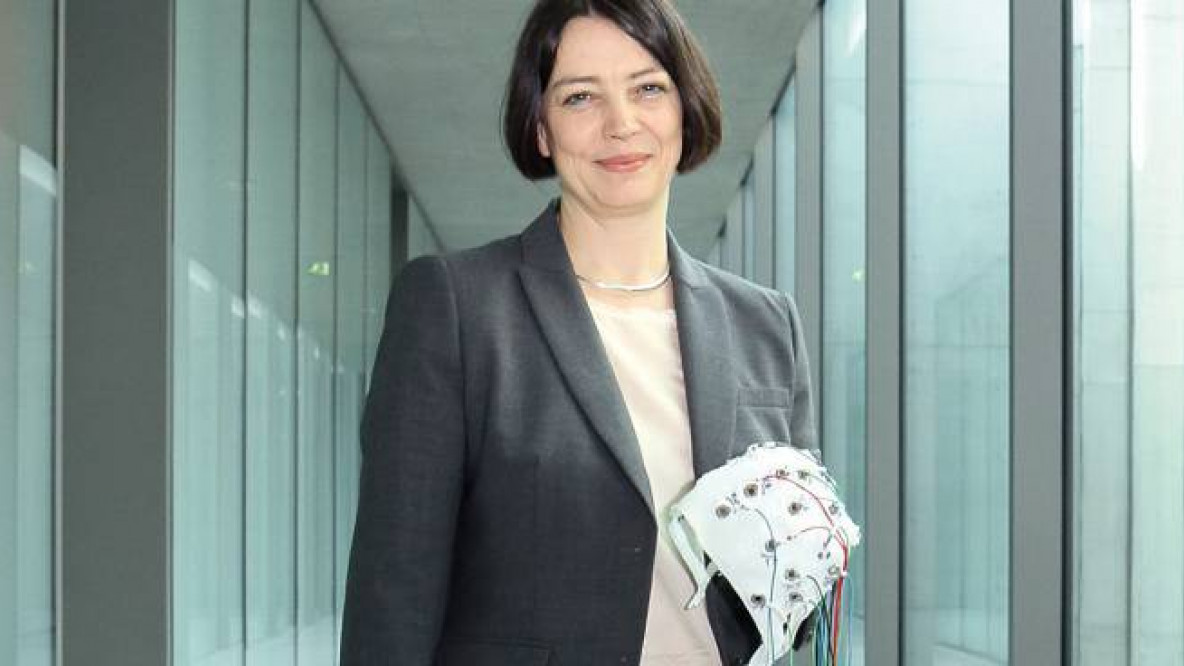Electric Language

Ulrike Domahs from unibz’s Faculty of Education is poised to open a new lab for Cognitive Education Science that will allow EEG researchers to delve further into the mysterious enigma that is the human brain.
“People think we can read their minds with it, but we can’t!”
Ulrike Domahs is talking about the EEG machine—those not-so-stylish skullcaps that measure the brain’s electrical activity through electrodes placed on the scalp. But rather than a scene from an evil sci-fi movie, Domahs’ use of the machine is giving us elegant (and totally un-scary) insight into how the human brain processes language.
The German-language professor from the unibz Faculty of Education is Director of the new Cognitive Educational Science (CES) Laboratory in Brixen/Bressanone. The Lab is open to all researchers interested in studying the cognitive processes going on in our noggins via the 20 million billion commands that our brain’s neurons are sending out every second.
Brain Waves and Language
An electroencephalograph (or EEG) represents this neural chatter as waves. The technology is not new by any means. Back in 1929, a “brooding and introverted” German scientist, Hans Berger, watched as his rudimentary EEG scratched out the first inky-black brain wave of a 17-year-old college student by the name of Zedel.
Within a few decades the EEG had become the staple tool of cognitive science. Scientists eventually identified six speeds of brainwaves—infra-low, delta, theta, alpha, beta and gamma–an orchestra of low to high bandwidths whose interactions are fundamental to understanding neurological disorders, sleep patterns and language.
“My wife spread butter and socks on her toast this morning.”
Ulrike Domahs’ research is based on an application of EEG technology called Event-Related Potentials (ERP). This approach measures the time it takes for the brain to react to a stimulus or event. For example, if a friend tells you: “My wife spread butter and socks on her toast this morning”, your brain will register a negative shift on the EEG recording at about 400 milliseconds after hearing “socks” (the so-called N-400 effect). By comparing the N-400s of many individuals, Domahs can see patterns in how the brain processes language under different conditions.
Language Acquisition
“We generally think about language processing as occurring after a language has been acquired,” says Domahs of her work. “But we know now that it can be affected by the amount of experience you have with a language. Therefore, it is important to know what’s going on in the brains of those learning a language, as well as those who are learning more than one language.”
To get an overview of this area of language processing, Domahs has performed ERP studies with many different tongues—Turkish, Arabic, Italian, English, German, to name a few—as well as many different age groups. In particular, she has worked with children to observe the development of their mental lexicons, the brain’s piggybank of information about the meaning, pronunciation, and so forth of a word. She also looked at how children use language rhythm to process words with grammatical endings (an example could be the singular and plural forms of the German for dogs, cats and birds: Hund vs Hund(e), Katze vs Katze(n) or Vogel vs V(ö)gel. In addition, she has worked with children with language impairment as well as with adults with a history of developmental language impairment to find out how language is affected by language disorders.
Soon Domahs will be comparing how Italian-German bilinguals and German monolinguals process language rhythm to see if these two groups react differently to stressed and unstressed syllables in words (for example, German Bárhocker versus Italian sgabello da bár. Research such as this is important in a multilingual society like South Tyrol, where questions of second-language acquisition are ever-present.
We still don’t know enough about the difference between mono- and bilingual language processing, but whatever language or languages are there in lightning storm of our cloudy-grey brain matter, Domahs’ research may shape the way we teach them in the future.
by Peter Farbridge
Academia #73 - April / Aprile 2016
Bühne frei / Dietro le quinte / Backstage Pass
Magazin der / Rivista di / Magazine of unibz & EURAC


Stimme zu, um die Kommentare zu lesen - oder auch selbst zu kommentieren. Du kannst Deine Zustimmung jederzeit wieder zurücknehmen.